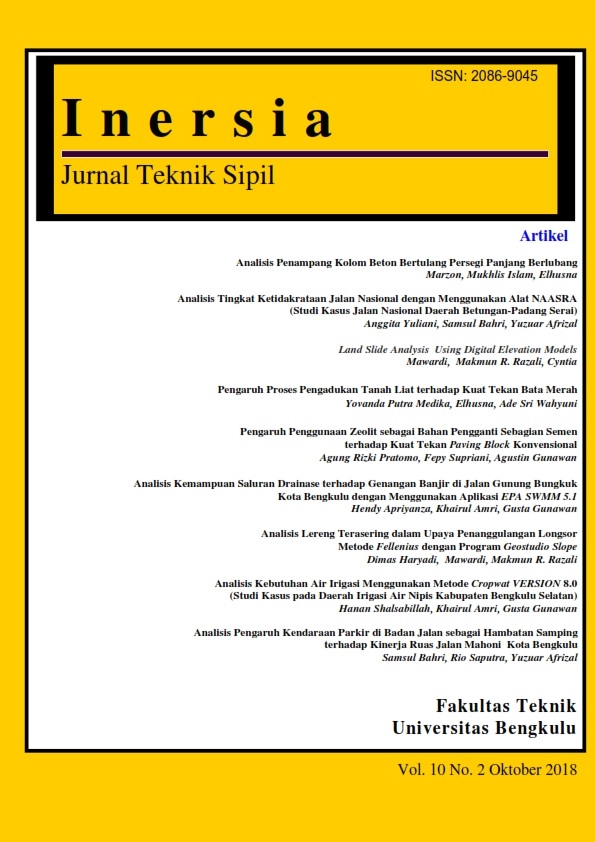Main Article Content
Abstract
This study aims to determine the flood discharge plan, discharge the existing channel and analyze the condition of the existing channel and look for alternatives to handling flood inundation at the location of flood inundation. Retrieval of data by measuring the existing channel in the flood inundation location. Calculation of peak discharge uses rational methods for various times of plan return. Rainfall calculation results of the plan that meets the requirements are type 1 Gumbel Method. The results of the research and calculations are
known that the amount of existing channel discharge in seven locations of flood inundation ie left and right Mountain Bambat Road is 0.934 m3 / sec and 3.798 m3 / sec. 2,261 m3 / sec, the left and right Gunung Bungkuk Roads are 0.134 m3 / sec and 0.164 m3 / sec while the flood discharge is 1.897 m3 / sec, Gunung Bungkuk 1 Road is 0.30 m3 / sec while the flood discharge is 0.471 m3 / sec, Gunung Bungkuk Road 4 hunchback of 0.190 m3 / sec while the flood
discharge is 1,336 m3 / sec and Gunung Bungkuk Road is 4 0,173 m3 / sec while the flood discharge is 0,864 m3 / sec and for the drainage of Jalan Gunung Bungkuk is not calculated the channel discharge is due to the channel being closed so that the channel dimension not obtained but for the flood discharge of 2.230 m3 / sec and 0.447 m3 / sec. Thus, it shows that the existing discharge channel on the existing Gunung Bungkuk Hump Mountain Road is unable to
accommodate the planned flood discharge. The alternative to flood inundation is by re-planning drainage channels, channel normalization activities, and improving coordination between the government and the community in maintaining drainage channels.
Article Details
Authors who publish with this journal agree to the following terms:
- Authors retain copyright and grant the journal right of first publication with the work simultaneously licensed under a Creative Commons Attribution License that allows others to share the work with an acknowledgment of the work's authorship and initial publication in this journal.
- Authors are able to enter into separate, additional contractual arrangements for the non-exclusive distribution of the journal's published version of the work (e.g., post it to an institutional repository or publish it in a book), with an acknowledgment of its initial publication in this journal.
- Authors are permitted and encouraged to post their work online (e.g., in institutional repositories or on their website) prior to and during the submission process, as it can lead to productive exchanges, as well as earlier and greater citation of published work (See The Effect of Open Access).
- This work is licensed under a Creative Commons Attribution-ShareAlike 4.0 International License.
References
- Ardiansyah, Amri, dan Besperi, 2017 Analisis Kemampuan Saluran
- Drainase terhadap Genangan Banjir di Kelurahan Talang Rimbo Baru Kota
- Curup. Teknik sipil, Universitas Bengkulu.
- Fachrizal dan Wesli., 2015. Analisa Kapasitas Saluran Primer terhadap
- Pengendalian Banjir Studi Kasus Sistem Drainase Kota Langsa, Teras
- Jurnal Vol.5 No.1 hal.70, Jurusan Teknik Sipil Universitas Malikussaleh, Kota Langsa.
- Purbawijaya, I.B., 2011. Manajemen Resiko Penanganan Banjir pada Sistem Jaringan Drainase di Wilayah Kota Denpasar, Jurnal Ilmiah Teknik
- Sipil Vol.15.No.1, Jurusan Teknik Sipil Universitas Udayana, Denpasar.
- Soewarno, 1995. Hidrologi Aplikasi Metode Statistik untuk Analisa Data
- Jilid 1, Bandung, Nova.
- Sriyono, E., 2012. Analisis Debit Banjir Rancangan Rehabilitas Situ Sidomukti, Jurnal Teknik Vol.2 No.2, Jurusan Teknik Sipil Fakultas Teknik Universitas Janabadra, Yogyakarta.
- Tigri, C., 2013. Tinjauan Sistem Dinase di Kelurahan Karame Kecamatan
- Singkil, Jurnal Statik, Vol.1 No.7, Fakultas Teknik Jurusan Teknik Sipil
- Universitas Sam Ratulangi Manado.
- Wesli, 2008. Drainase Perkotaan,Yogyakarta, Graha Ilmu.
References
Ardiansyah, Amri, dan Besperi, 2017 Analisis Kemampuan Saluran
Drainase terhadap Genangan Banjir di Kelurahan Talang Rimbo Baru Kota
Curup. Teknik sipil, Universitas Bengkulu.
Fachrizal dan Wesli., 2015. Analisa Kapasitas Saluran Primer terhadap
Pengendalian Banjir Studi Kasus Sistem Drainase Kota Langsa, Teras
Jurnal Vol.5 No.1 hal.70, Jurusan Teknik Sipil Universitas Malikussaleh, Kota Langsa.
Purbawijaya, I.B., 2011. Manajemen Resiko Penanganan Banjir pada Sistem Jaringan Drainase di Wilayah Kota Denpasar, Jurnal Ilmiah Teknik
Sipil Vol.15.No.1, Jurusan Teknik Sipil Universitas Udayana, Denpasar.
Soewarno, 1995. Hidrologi Aplikasi Metode Statistik untuk Analisa Data
Jilid 1, Bandung, Nova.
Sriyono, E., 2012. Analisis Debit Banjir Rancangan Rehabilitas Situ Sidomukti, Jurnal Teknik Vol.2 No.2, Jurusan Teknik Sipil Fakultas Teknik Universitas Janabadra, Yogyakarta.
Tigri, C., 2013. Tinjauan Sistem Dinase di Kelurahan Karame Kecamatan
Singkil, Jurnal Statik, Vol.1 No.7, Fakultas Teknik Jurusan Teknik Sipil
Universitas Sam Ratulangi Manado.
Wesli, 2008. Drainase Perkotaan,Yogyakarta, Graha Ilmu.
